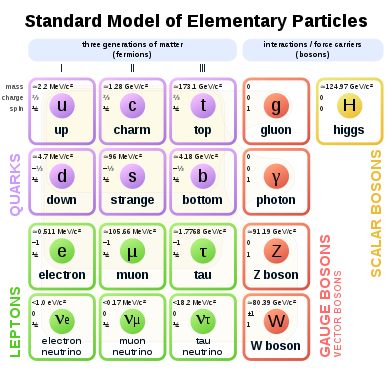Neutral current
Weak neutral current interactions are one of the ways in which subatomic particles can interact by means of the weak force. These interactions are mediated by the
Z
boson. The discovery of weak neutral currents was a significant step toward the unification of electromagnetism and the weak force into the electroweak force, and led to the discovery of the W and Z bosons.
| Standard Model of particle physics |
|---|
 |
|
Scientists Rutherford · Thomson · Chadwick · Bose · Sudarshan · Koshiba · Davis Jr. · Anderson · Fermi · Dirac · Feynman · Rubbia · Gell-Mann · Kendall · Taylor · Friedman · Powell · P. W. Anderson · Glashow · Iliopoulos · Maiani · Meer · Cowan · Nambu · Chamberlain · Cabibbo · Schwartz · Perl · Majorana · Weinberg · Lee · Ward · Salam · Kobayashi · Maskawa · Yang · Yukawa · 't Hooft · Veltman · Gross · Politzer · Wilczek · Cronin · Fitch · Vleck · Higgs · Englert · Brout · Hagen · Guralnik · Kibble · Ting · Richter |
In simple terms
The weak force is best known for its role in nuclear decay. It has very short range but (apart from gravity) is the only force to interact with neutrinos. The weak force is communicated via exchange particles like other subatomic forces. Perhaps the most well known of the exchange particles for the weak force is the W particle which is involved in beta decay. W particles have electric charge – there are both positive and negative W particles – however the Z boson is also an exchange particle for the weak force but does not have any electrical charge. Exchange of a Z boson transfers momentum, spin, and energy, but leaves the interacting particles’ quantum numbers unaffected – charge, flavor, baryon number, lepton number, etc. Because there is no transfer of electrical charge involved, exchange of Z particles is referred to as “neutral” in the phrase “neutral current”. However the word “current” here has nothing to do with electricity – it simply refers to the exchange of the Z particle.
Definition
The neutral current that gives the interaction its name is that of the interacting particles. For example, the neutral-current contribution to the
ν
e
e−
→
ν
e
e−
elastic scattering amplitude
where the neutral currents describing the flow of the neutrino and of the electron are given by
with and are the vector and axial vector couplings for fermion . These couplings amount to essentially left chiral for neutrinos and axial for charged leptons.
The
Z
boson can couple to any Standard Model particle, except gluons and photons. However, any interaction between two charged particles that can occur via the exchange of a virtual
Z
boson can also occur via the exchange of a virtual photon. Unless the interacting particles have energies on the order of the
Z
boson mass (91 GeV) or higher, the virtual
Z
boson exchange has an effect of a tiny correction () to the amplitude of the electromagnetic process.
Particle accelerators with energies necessary to observe neutral current interactions and to measure the mass of
Z
boson weren't available until 1983.
On the other hand,
Z
boson interactions involving neutrinos have distinctive signatures: They provide the only known mechanism for elastic scattering of neutrinos in matter; neutrinos are almost as likely to scatter elastically (via
Z
boson exchange) as inelastically (via
W
boson exchange). Weak neutral currents were predicted in 1973 by Abdus Salam, Sheldon Glashow and Steven Weinberg,[1] and confirmed shortly thereafter in 1973, in a neutrino experiment in the Gargamelle bubble chamber at CERN.
See also
- Charged current
- Electric current
- Flavor changing neutral current
- Quantum chromodynamics
References
- "The Nobel Prize in Physics 1979". Nobel Foundation. Retrieved 2008-09-10.
External links
- "Discovery of weak neutral currents". CERN Courier.
- "Gargamelle". CERN public web. Research. Archived from the original on 2011-08-27. Retrieved 2011-08-27.
- "Neutral current interaction". Britannica.
- Nave, R. "Neutral current". GSU.
- Nieves, J.; Valverde, M.; Vicente Vacas, M.J. (2006). "Charged and neutral current neutrino induced nucleon emission reactions" (PDF). Acta Physica Polonica B. 37 (8): 2295–2301. Archived from the original (PDF) on 21 January 2012.
- "Gargamelle". Symmetry Magazine. 2009-07-07.
- Fraser, Gordon (3 November 1998). "Twenty-five years of neutral currents". CERN Courier. 27904.
Gordon Fraser looks back at how confirmation of the existence of neutral currents ushered in a new understanding of physics.
- Padilla, Antonio (Tony). Brady Haran (ed.). "Gargamelle and neutral currents". Sixty Symbols. University of Nottingham.